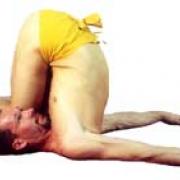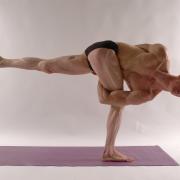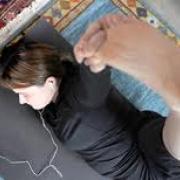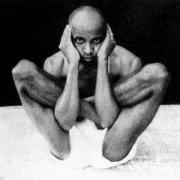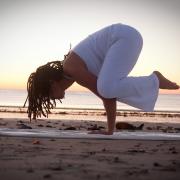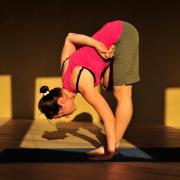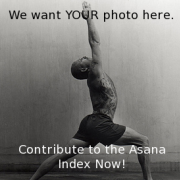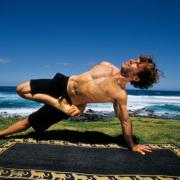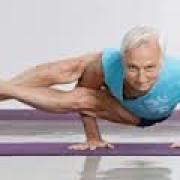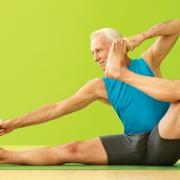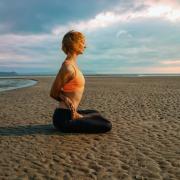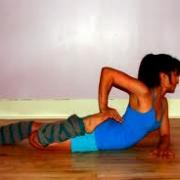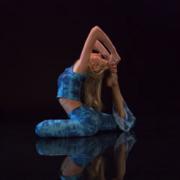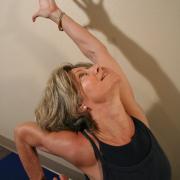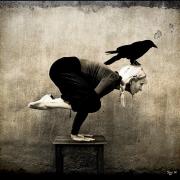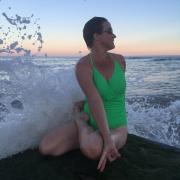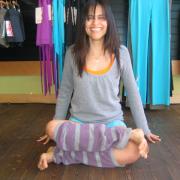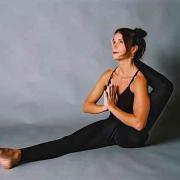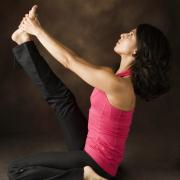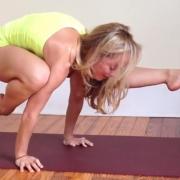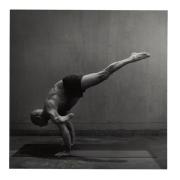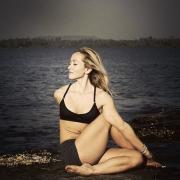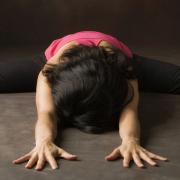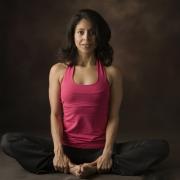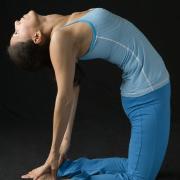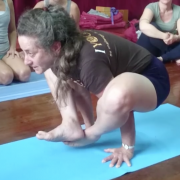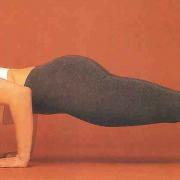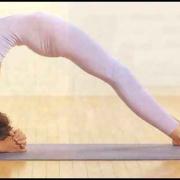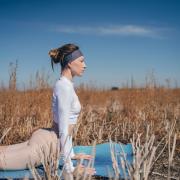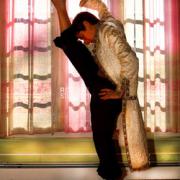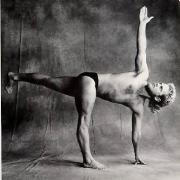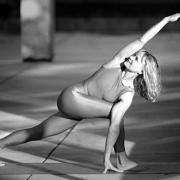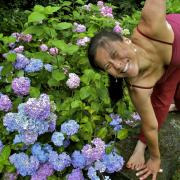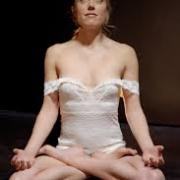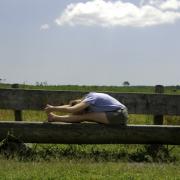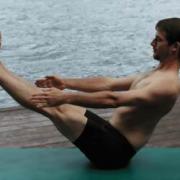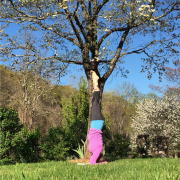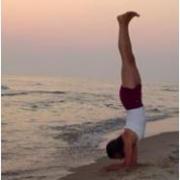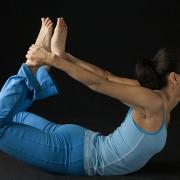Show Us Your Asana! Share your yoga poses and teachings.
Intermediate
Displaying 51 - 100 of 164 » page 2 of 4
Asana
Geometry: The standing leg and torso are in Uttanasana with one leg extended up towards the ceiling.
In this preparation for the full pose, the right leg is in ardha padmasana and the left leg is in pascimottanasana. Hold the foot (or a strap) and extend the torso over the straight leg.
From Dandasana, reach the right hand behind the right knee and draw the knee out to the side, creating space behind the back of hte right knee as you do so. Reach the left hand underneath the right foot and draw the foot up into the top of the left thigh and release the foot onto the thigh. Release the right hand from behind the right knee.
Geometry: In this inverted pose, all my limbs are supported on my upper arms and shoulders. The back of my head is on the ground. One leg stays in line with the hips and shoulders and one leg extends overhead in halasana.
Actions:
From Halasana or Ardha Halasana.
Exhale and take the right leg straight up towards the ceiling. Move the back towards the front of the body and lift the chest. Exhale and take the right leg down to Halasana/Ardha Halasana. Extend through the feet and straighten the legs as you lower one leg at a time towards the floor.
Stretch the left leg from the groin upwards.
Draw in the left knee and keep it taut.
(with support , eg. Folded blanket between buttock and foot; against wall (LOY 307 (wrapping arms around knee-308 – arm outside thigh)– Siva explained to his consort, Parvati, the mysteries of yoga. A fish nearby listened the entire talk and remained motionless. Siva sprinkled water on the fish so he gained a divine form and became Matsyendra who thereafter spread the knowledge of Yoga.
Geometry: Standing on my shins, my feet and shins are parallel. My thighs are perpendicular to the floor. My chest stretches backwards and my arms are stretched straight with the hands on the heels (or palms on the soles of the feet).
Geometry: This pose is a variation of Salabhasana where the hands are interlaced behind the head, elbows shoulder-width or slightly wider.
Geometry:The four limbs of the hands and feet support the weight of the body. The body is straight, strong and steady like a staff. The hands are shoulder width and parallel. Hands in line with lower ribs.The legs are hip width and parallel.
Geometry: Hands Underneath Shoulders. Chest Lifted. Legs Stretched Back. Toes point straight back. And Legs straight. Arms Straight. Shoulders over wrists.
Actions:
Lie on the floor in a prone position. Face Downwards.
This pose is done by standing on one leg, extending the other leg parallel to the floor or higher in front, holding the toe of the extended leg with the extended arm (ultimately resting the head on the leg).Classification: Udara Akunchana KriyaGeometry: Left Leg is Straight as in Tadasana. Right leg is extended. Pelvis is level. Torso is Vertical as in Tadasana. Arms stretch straight. Hands Hold the foot or a strapVariations:
a. Supported and standing facing the wall
a. Supported and standing facing the wall
Classification: Parivrtta KriyaGeometry: The standing leg is perpendicular to the floor. The pelvis is level and the lifted leg is parallel to the floor. The torso is revolved towards the standing leg and the arms are stretched straight from the shoulders.Actions:
Do Parivrtta Trikonasana. With the hand on the floor/block on the inside of the foot.Bend the right leg and place the left hand 1.25 feet away from the right foot and step in with the left foot.
Do Parivrtta Trikonasana. With the hand on the floor/block on the inside of the foot.Bend the right leg and place the left hand 1.25 feet away from the right foot and step in with the left foot.
Classification: Parivrtta Kriya
Geometry: The legs are as in Vimanasana or Virabhadrasana I. Back leg is stretched straight. The front leg knee is in a 90 degree angle. Torso revolved towards the bent knee. Left hand stretched straight to the outside of the bent knee. Right arm overhead by the ear.
Actions:From Tadasana, UHP, PHP, Bend the right knee to a right angle into Virabhadrasana II.Pivot on the back heel and turn the entire trunk, pelvis and abdomen towards the bent leg in Vimanasana.Inhale. Raise the left arm and take the left side of the abdomen over the right thigh.
Geometry: The legs are as in Vimanasana or Virabhadrasana I. Back leg is stretched straight. The front leg knee is in a 90 degree angle. Torso revolved towards the bent knee. Left hand stretched straight to the outside of the bent knee. Right arm overhead by the ear.
Actions:From Tadasana, UHP, PHP, Bend the right knee to a right angle into Virabhadrasana II.Pivot on the back heel and turn the entire trunk, pelvis and abdomen towards the bent leg in Vimanasana.Inhale. Raise the left arm and take the left side of the abdomen over the right thigh.
The legs are as in parsvottanasana. The pelvis is level and the torso and chest are revolved towards the forward leg. The Torso is in line with the legs and hips. The arms stretch from the shoulders and the gaze is up towards the top hand.
Garudasana means eagle. It is also the name of the king of the birds. Garuda is represented as the vehicle of Vishnu and as having a white face, an aquiline beak, red wings and a golden body. (An aquiline nose (also called a Roman nose or hook nose) is a human nose with a prominent bridge, giving it the appearance of being curved or slightly bent.)Classification: Grathana Kriya - Entwining Action
Geometry: Legs are Bent and Entwined. Arms are bent and entwined. Gaze is forward. A. Hand Position
Geometry: Legs are Bent and Entwined. Arms are bent and entwined. Gaze is forward. A. Hand Position
Extend the inner thighs back to create space to move the abdomen forward.
Draw the lower back ribs in to take the front lower ribs forward over the legs.
Geometry: The back of the body is rounded like a canoe, The hands are interlaced behind the head. The legs are stretched straight, the crown of the head in line with the toes.
Sit in Dandasana. Roll the top inner thighs in and extend through the inner line of the legs through the inner ankles.
Interlock the fingers and place them behind the head just above the neck. The elbows are shoulder width or slightly wider.
Exhale and recline the trunk back and simultaneously raise the legs from the floor. The balance of the body rests on the buttocks and no part of the spine touches the floor.
Tighten the knees and extend the toes towards the ceiling. Breathe.
Geometry:
The torso and legs are in an upward V - shaped like a boat. The arms are stretched straight, shoulder-width and parallel to the floor. Actions:
1. Knees Bent.
2. Legs Straight.
The torso and legs are in an upward V - shaped like a boat. The arms are stretched straight, shoulder-width and parallel to the floor. Actions:
1. Knees Bent.
2. Legs Straight.
Geometry: In this inverted posture the weight of the body is on the forearms and the body is balanced on the head. The torso and legs stretch straight up as in Tadasana.
Orientation in Room: Teach with your back to the students so they can see your shoulders lift up away from the floor. Take beginner students to the wall. If the student's back is on the wall, then do not go up but stay in ardha sirsasana.
Geometry: Chest and Legs are Lifted. The feet and legs are slightly apart. The arms are stretched straight to reach the ankles. The entire body is curved like a bow and is held with the arms as if forming a string to bend the bow.First Teaching:Lie on the abdomen, roll the fronts of the thighs in, bend the knees and bring the feet towards the buttocks.Take the arms behind and catch hold of the ankles, right ankle with the right hand and left ankle with the left hand.Grip the ankles, raise the chest, knees and thighs up away from the floor.The body rests on the lower abdominal area. The ribs and thighs do not touch the floor.Lift the head and look up.
Pages
Are you a Yoga Teacher?
Are you a Yoga Student?
Do you Own a Yoga Studio?

